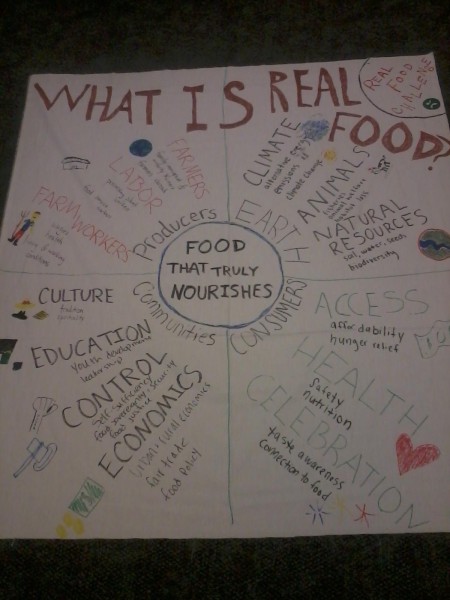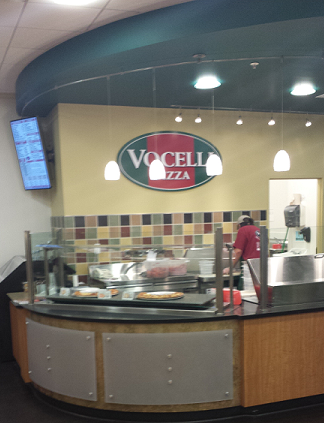It is easy to eat mindlessly. Especially in the context of a college cafeteria, where a new, steaming tray of food appears just as the one before it is depleted, where milk comes from dispensers and eggs are poured like juice from cartons, it seems cumbersome, almost silly, to trace our food back to its source.
As freshman Casey Kelahan said, “It’s just a daily routine: we go to Glar, go down the line, eat what’s there.”
When you do begin to trace, however, you find a food system that values mass production over sustainability and the rights of farmers, laborers, and animals compromised as a result. Mounting diet-related diseases in the United States along with climate change share roots in the way food is currently produced and consumed. A growing national interest in and concern for our broken food system has moved people across the country to search for lasting solutions, one of these being the Real Food Challenge, which focuses specifically on increasing the sustainability of food on college campuses.
Jon Berger, Mid-Atlantic Coordinator for the Real Food Challenge, explains that the movement specifically aims to change the food on college campuses because “college students have long been at the forefront of new social movements, and are often forced to buy into meal plans that support the destructive system of chemical-based industrial agriculture.” He considers participating in the Real Food Challenge to be both a learning opportunity and a chance to demand change.
The challenge defines real food as that which is good for producers, consumers, communities, and the earth. Within these categories, issues from immigrant rights to maintaining crop diversity are considered, allowing food activists of all types to find a voice and a place in the movement.
According to their website, the primary goal of the Real Food Challenge is “to shift $1 billion of existing university food budgets away from industrial farms and junk food and towards local/community-based, fair, ecologically sound and humane food sources—what we call ‘real food’—by 2020.”
In order to achieve this goal, interested students collaborate with their food provider in order to complete the Real Food Calculator, a tool which allows students to examine the quality of the food served in their cafeteria and determine how much of it meets the standards of the Real Food Challenge. From there, students work to gain support from the campus community, from students to administrators, in order to increase the amount of real food served on campus.
Upon learning about the Real Food Challenge, freshman Caroline Unger jumped at the opportunity to bring the movement to McDaniel.
“There is an enormous lack of awareness of where our food comes from and how ethically it is produced, and I wanted to change that,” she said. “I found out about RFC and it seemed like the perfect route to create a completely student-based movement to change the food system for the better, starting with our own small school.”
McDaniel’s chapter of the Real Food Challenge has been meeting weekly to discuss the current food system, work on gaining campus support, and begin using food orders and invoices to fill out the Real Food Calculator.
Kelahan, who cites her interest the environment as the driving factor in becoming part of the Real Food Challenge at McDaniel, explained that attending meetings has been a “good way to learn more about the food system.”
Because becoming involved with the Real Food Challenge heavily involves monitoring food purchases, McDaniel seems to have joined the movement at an opportune moment. Our food service provider, Sodexo, signed a transparency agreement with the Real Food Challenge on April 4, 2013, which allows students access to the purchasing records of their school and easily complete the Real Food Calculator.
Though the transparency agreement has simplified the process of examining the food currently offered by McDaniel, the success of the Real Food Challenge depends heavily on support from the campus community.
Unger stresses the importance of students using their voices and their influence to demand better, fairer food.
“Students becoming part of RFC are part of a national movement for a fairer food system, and working together is so much more effective [than working alone],” she said. “We are the ones that eat at Glar every day, and therefore we should be able to have a say in the food itself.”
If you are interested in becoming a part of the Real Food Challenge at McDaniel, please send an email to clu001@mcdaniel.edu.






“McDaniel’s chapter of the Real Food Challenge has been meeting weekly to discuss the current food system, work on gaining campus support, and begin using food orders and invoices to fill out the Real Food Calculator… Because becoming involved with the Real Food Challenge heavily involves monitoring food purchases, McDaniel seems to have joined the movement at an opportune moment. Our food service provider, Sodexo, signed a transparency agreement with the Real Food Challenge on April 4, 2013, which allows students access to the purchasing records of their school and easily complete the Real Food Calculator.”
Where’s the “transparency” in Glar, McDaniel College?